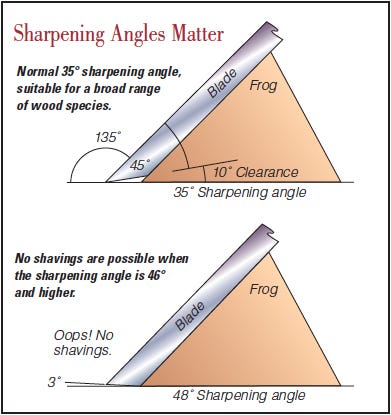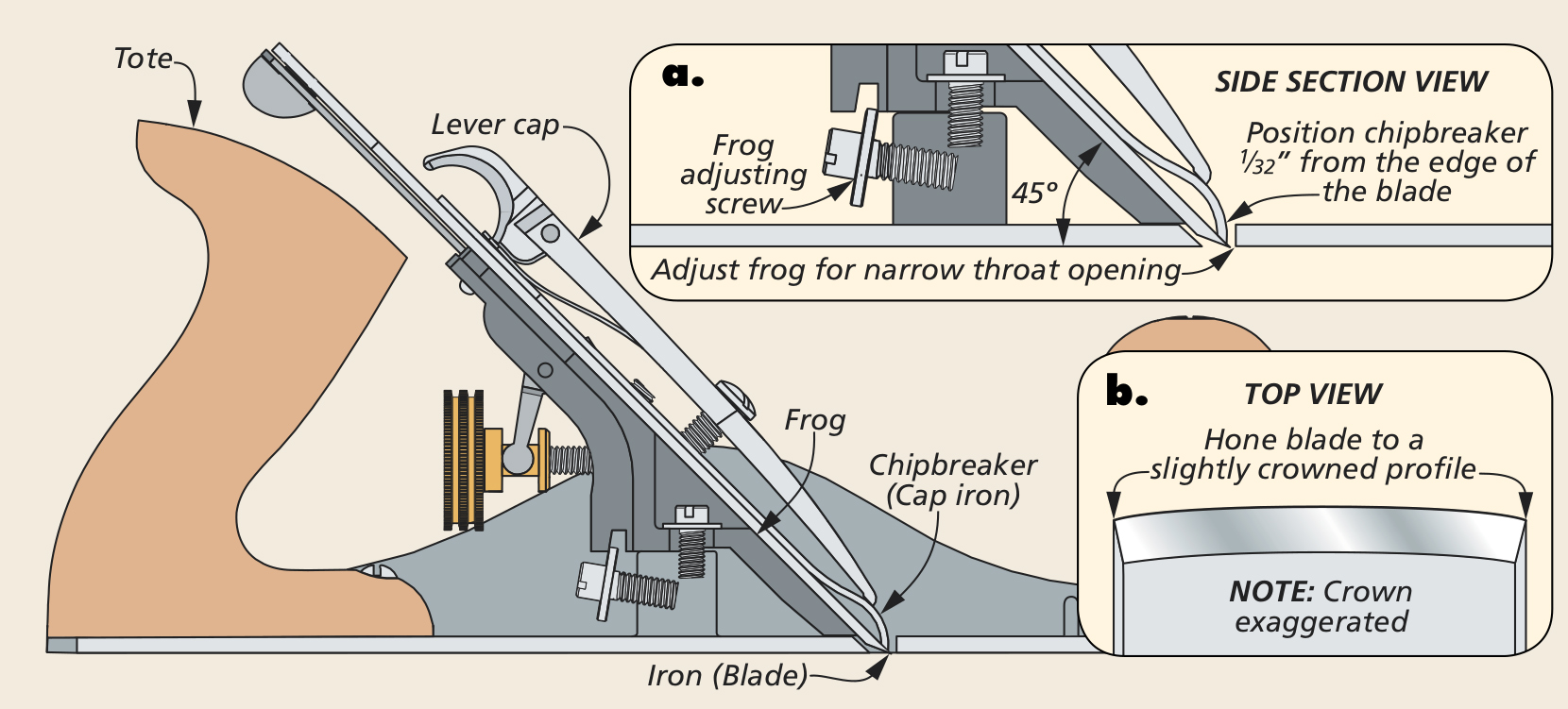So, you’ve got yourself a hand plane and you’re ready to get to work. But wait, what angle do you sharpen a hand plane? Well, you’ve come to the right place! I’m here to guide you through the ins and outs of sharpening a hand plane and finding that perfect angle for optimal performance.
Sharpening a hand plane may seem like a daunting task, but fear not! With just a little know-how, you’ll be able to get your hand plane sharper than ever before. And trust me, a sharp hand plane can make all the difference when it comes to achieving smooth and precise cuts in your woodworking projects.
So, whether you’re a seasoned pro or just starting out, let’s dive into the world of hand plane sharpening and discover the angle that will take your woodworking to the next level.

What Angle Do You Sharpen a Hand Plane?
When it comes to sharpening a hand plane, the angle at which you sharpen the blade is a crucial factor in achieving optimal performance. The angle determines how the blade interacts with the wood and affects the quality of the cut. Finding the right angle for your hand plane can greatly improve its effectiveness and efficiency. In this article, we will explore the different angles you can sharpen a hand plane at, and the considerations to keep in mind when choosing the ideal angle for your woodworking projects.
Why Does the Sharpening Angle Matter?
The sharpening angle of a hand plane blade directly affects how the blade cuts through the wood. It determines the type and depth of cut the plane will make, as well as the level of control you have over the tool. The blade angle influences the slicing action and the amount of resistance encountered during planing. A lower angle results in a more aggressive cut and is suitable for end grain or difficult grains. On the other hand, a higher angle offers a smoother and more controlled cut, ideal for planing long-grain surfaces. The choice of angle depends on the desired finish, wood type, and personal preference.
Blade Angle Options
There are three common blade angles that woodworkers typically use when sharpening a hand plane: low angle, standard angle, and high angle.
Low Angle
The low angle, typically around 25 degrees, is great for planing end grain and difficult woods. This angle allows the blade to slice through the wood fibers more easily, making it less likely to tear out the grain. The low angle is also useful for planing highly figured woods or working with delicate materials. However, it may not provide the smoothest finish on long-grain surfaces since it can be more prone to tearing the fibers.
Standard Angle
The standard angle, around 45 degrees, is the most commonly used blade angle for hand planes. It offers a balance between aggressive cutting and smooth finish. This angle works well for general purpose planing and delivers a clean cut on most wood types. The 45-degree angle is versatile, making it a popular choice for both experienced woodworkers and beginners.
High Angle
The high angle, usually between 50 and 55 degrees, provides a more controlled cut and is ideal for working with difficult grains and end grain. It excels at producing tear-free surfaces and is commonly used for smoothing and finishing applications. The higher angle also helps with reducing tear-out on figured woods and minimizing the impact of knots in the wood. However, the high angle can require more effort to push through the wood and may not be as efficient for heavy removal of material.
Factors to Consider When Choosing the Angle
While the above blade angles offer general guidelines, there are several factors to consider when choosing the sharpening angle for your hand plane:
- Wood type: Different types of wood behave differently, and some require specific blade angles for optimal results. Experimentation and experience will help you identify the best angles for specific wood species.
- Grain orientation: The direction of the wood grain can affect the choice of angle. End grain, cross grain, and long grain all have different characteristics that may require different blade angles.
- Desired finish: Consider the final surface you want to achieve. A lower angle may leave a rougher surface, while a higher angle can produce a smoother, more refined finish.
- Blade sharpness: A sharper blade can perform well at lower angles, while a dull blade may require a higher angle to compensate for less effective cutting.
- Experience and preference: As you gain experience and develop your technique, you may discover a preferred angle that works best for your style of woodworking.
Maintaining a Sharp Blade
Regardless of the angle you choose, keeping your hand plane blade sharp is essential for optimal performance. Regular sharpening and honing will ensure clean cuts and minimize tear-out. Remember to use quality sharpening tools and follow proper techniques to maintain the sharpness of your blade.
Conclusion
Choosing the right angle to sharpen a hand plane blade is crucial for achieving the desired results in your woodworking projects. Consider the wood type, grain orientation, desired finish, blade sharpness, and personal preference when deciding on the angle. Experimentation and practice will help you refine your techniques and find the angle that works best for your style of work. Keeping your blade sharp and maintaining it regularly will ensure consistent performance and a satisfying woodworking experience.
Key Takeaways: What Angle Do You Sharpen a Hand Plane?
- Sharpening a hand plane requires setting the bevel angle.
- The bevel angle commonly used for hand planes is around 25-30 degrees.
- A higher bevel angle (around 30 degrees) provides more durability and is suitable for harder woods.
- A lower bevel angle (around 25 degrees) offers greater slicing action and is ideal for softwoods and end grain.
- Experimenting with different bevel angles can help you find the optimal cutting performance for your specific hand plane.
Frequently Asked Questions
When it comes to sharpening a hand plane, many people wonder about the angle they should use. Here are answers to some commonly asked questions about the angle for sharpening a hand plane.
1. What is the recommended angle for sharpening a hand plane?
The recommended angle for sharpening a hand plane can vary depending on the type of plane and the type of wood you’ll be working with. However, a standard angle range is between 25 to 35 degrees. A lower angle, such as 25 degrees, is typically used for end grain and softer woods. A higher angle, like 35 degrees, is commonly used for harder woods and achieving smoother finishes. It’s important to test and experiment with different angles to find the one that suits your specific needs and woodworking techniques the best.
Keep in mind that when sharpening a hand plane, the bevel angle and the honing angle need to be taken into consideration. The bevel angle refers to the angle at which the blade is ground, while the honing angle is the angle at which the blade is sharpened after grinding. These angles can be adjusted to achieve the desired cutting performance and edge durability.
2. How do I determine the angle for sharpening my hand plane?
Determining the angle for sharpening your hand plane involves considering the type of wood you’ll be working with and the desired performance. A good starting point is to refer to the manufacturer’s recommendations for the specific plane you’re using. Additionally, you can consult woodworking experts or online resources for general guidelines based on the wood type and the intended use of the hand plane.
Another approach is to experiment with different angles on scrap wood to see which angle gives you the desired result. You can start with a moderate angle and gradually adjust it based on your observations. Remember that different angles can affect the cutting performance, ease of use, and smoothness of the finish. Don’t be afraid to find what works best for you through trial and error.
3. Are there any special considerations for sharpening a bevel-up hand plane?
When sharpening a bevel-up hand plane, the angle to consider is the bedding angle. The bedding angle is the angle at which the blade sits in the plane’s body. Most bevel-up planes have a bedding angle of around 12 to 15 degrees. This angle affects the effective cutting angle of the plane. To determine the total cutting angle, you need to add the bedding angle to the bevel angle of the blade.
For example, if you have a bevel-up plane with a 12-degree bedding angle and a 30-degree bevel angle, the total cutting angle would be 42 degrees. It’s important to keep this total cutting angle in mind when sharpening a bevel-up hand plane to ensure optimal performance and cutting efficiency.
4. What tools and techniques can I use to sharpen a hand plane?
There are various tools and techniques you can use to sharpen a hand plane. Some common tools include sharpening stones, honing guides, and a strop. Sharpening stones offer different grits for coarse and fine sharpening, allowing you to gradually refine the cutting edge. A honing guide helps maintain a consistent angle during sharpening, while a strop is used for final polishing and honing.
As for techniques, many woodworkers prefer the “scary sharp” method, which involves using sandpaper adhered to a flat surface to sharpen the blade. Others may use a sharpening jig or follow traditional methods by hand. Experiment with different tools and techniques to find what works best for you and produces the desired results for your hand plane sharpening.
5. How often should I sharpen my hand plane?
The frequency of sharpening your hand plane depends on various factors such as the type of wood you’re working with, the project’s scale, and your personal preference. However, as a general guideline, it’s recommended to sharpen your hand plane whenever you notice a decrease in its performance. Signs that indicate the need for sharpening include tear-out, difficulty in making clean cuts, or increased effort required to push the plane through the wood.
Some woodworkers prefer to sharpen their hand planes before starting a new project, while others might do it more frequently throughout the project to ensure consistent cutting performance. Regular maintenance of the blade’s sharpness will not only enhance the quality of your woodworking but also make the process more efficient and enjoyable.

Summary
Sharpening a hand plane is important for smooth woodworking. There are different angles to consider.
The bevel angle determines the sharpness of the blade. A low angle is good for end grains. A higher angle works well for difficult grains.
The honing angle is the angle you hold the blade against the stone. A higher angle gives a stronger edge. A lower angle gives a sharper edge.
Remember to flatten the back of the blade. This helps with effective sharpening. And always use caution when working with sharp tools!
